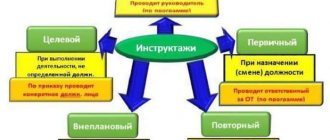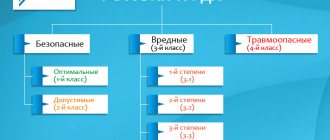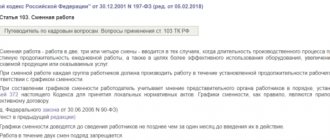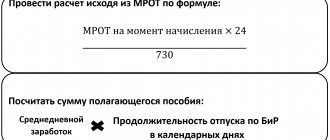Business lawyer > Labor law > What are the working conditions: assessment system and classification
It is the employer's responsibility to create optimal working conditions for employees. Rational intensity of work and a comfortable environment make it possible to obtain improved results in all spheres of the economy. Failure to comply with legal regulations when organizing the work of a team not only reduces its productivity. It directly violates the rights of employees and can cause harm to their health or life. In this case, management risks receiving a fine from the Labor Inspectorate and judicial authorities, and in some cases even facing criminal liability.
Factors influencing labor intensity
The Labor Code allows you to understand what working conditions are like. In 2013, a separate federal law No. 426 was adopted. Legal acts approved acceptable standards, set out criteria for assessing working conditions, provided for the procedure for working in difficult and dangerous conditions and compensation for personnel for risks.
It is incorrect to assume that working conditions only include the creation of safe workplaces. The concept includes a whole range of requirements.
These include:
Schedule
- work schedules
- maintaining the balance of work and rest
- the correct level of intensity of work performed
- permission to work for employees based on their qualifications
- their certification in terms of special skills, ability to use equipment and knowledge of safety precautions
All these requirements must be observed and controlled by the management of the enterprise (Article 212 of the Labor Code).
Work intensity is one of the most important factors in determining working conditions. The indicator is calculated based on human resource costs per unit of labor time.
Concept
What are working conditions in the workplace?
The definition of the concept of “working conditions” has come a long ( even centuries ) way. The road from the ruthless exploitation of workers to more informed regulation of the work process, largely based on the opinions of doctors and experts. They received their final embodiment in national legislation.
According to Articles 56 and 57 of the Labor Code of the Russian Federation, an employment contract cannot be concluded without specifying working conditions. They must be indicated along with basic data, such as the employee’s full name, salary, etc.
Article 56 states that the employer is obliged to provide working conditions provided for by law.
And in Article 57 there is a clause that states that it is necessary to highlight the characteristics of working conditions in the employment contract, the harmful factors that the employee may encounter. The compensation and guarantees due to him must be specified separately .
Manufacturing Process Characteristics
A production process is a planned activity to transform matter/raw materials into a specific product .
Actions in such a process are connected in one chain, where all links are interdependent.
The nature of the process can be determined by:
- the type of workforce involved;
- means of production;
- starting materials/raw materials.
a plant's primary means of production much can be said about the type of process that occurs there. Let's say we know that the main machine at the enterprise is a certain metallurgical installation.
Then it becomes clear that there is work going on with metal, with ore. The workforce consists of metallurgists, steelworkers, etc.
From this fact, one can roughly imagine what safety requirements should be established and what occupational diseases are most likely.
Work environment
The production environment is the space where a worker carries out work activities. The concept includes buildings, means of production, and transport used .
It also includes psychological and environmental conditions. The combination of these conditions has a constant impact on the employee.
Labor intensity
Labor intensity, in socio-economic literature, is the intensity of the work process .
The concept includes both psychological factors and objective information.
Work intensity is closely related to productivity.
In a poorly organized workplace, tension will be high and productivity will be low.
This is the most negative option . The employee gets tired quickly, and the result is unsatisfactory.
Nuances of monitoring
The assessment can be carried out per employee, per production group, or per average of all staff units of the enterprise within the reporting period (working hour, day, week, etc.).
The assessment is comprehensive and includes:
- expenditure of physical strength
- consumption of mental resources
- emotional background
- work environment
- the presence of motivation of a material and other nature
- convenience of work organization, etc.
The assessment procedure must take into account the intensity group to which the employee or the enterprise as a whole belongs.
There are four of them:
Increased physical labor
- Work that does not require physical labor.
- Light work.
- Work of average physical difficulty.
- Work under conditions of increased physical activity.
The first group mainly includes employees who perform sedentary work and engage in intellectual work. Light physical activity is used in the service segment or in production occupations where personnel monitor the operation of mechanized equipment. Factory and plant production, as well as agricultural enterprises, are classified as organizations of medium-sized physical labor. And increased loads are the norm in hazardous and heavy industries, for example, in the extraction of hydrocarbons and metals.
How to cancel benefits when you drop in level
All possible benefits are canceled when the official conclusions of the commission are provided on the need to reduce class to second. In this case, an order is issued for the enterprise, which indicates the cancellation of benefits due to a decrease in the level of working conditions from harmful to acceptable.
Note! The results of the examination and the order must also be agreed upon with Rospotrebnadzor; it is important to justify the need to cancel benefits.
The second class of working conditions indicates that the influence of various production conditions on the employee is small and acceptable. This means that the employee is not entitled to benefits, and there is no need for regular medical examinations. Based on the results of the special assessment, the class is specified in the contract. There is a special section for this called “Labor Safety”.
Monitoring criteria
Monitoring of work intensity should be carried out based on factors that directly influence the formation of this indicator:
- level of employment of each employee
- speed of work
- the size and severity of objects that the employee has to use during work
- volume of work performed
- compliance with sanitary and hygienic standards
For each of the criteria, there are maximum permissible values and standards approved at the state level.
Difficulty of work
In addition, the assessment takes into account:
- level of complexity of the technological process
- convenience of the workplace
- quality of the employee (gender, age, state of health, degree of fatigue, medical limitations, standard of living, social status, etc.)
Based on the number of factors that need to be taken into account, intensity monitoring is a multifactorial and complex process. It requires the development and application of special techniques that are capable of analyzing all the characteristics of the work.
Medical examination for second level personnel
Personnel who have received the second degree of working conditions are not required to undergo periodic medical examinations. This should be established at the state level and mean that there is no need for passage. Therefore, this condition was confirmed by the Rospotrebnadzor organization in 2015.
It states that persons with harmful and dangerous conditions in the work environment should undergo regular medical examinations. As well as persons associated with transport traffic. This is done in order to identify the ability of workers to perform tasks normally and prevent occupational diseases.
Using the results
Intensity monitoring allows you to adjust your workflow and achieve planned results as efficiently as possible.
Violation of the intensity indicator has an inversely proportional effect on labor productivity:
- Optimal load generates optimal performance.
- By increasing the voltage during work, you can provoke a jump in productivity, but only for a short period of time.
- Long-term increased exploitation of employees will invariably lead to decreased productivity.
Despite the statistics, many managers try to increase productivity precisely by increasing the intensity of workers' work. Coercive measures are still in use, such as orders to work beyond normal limits under the threat of dismissal or refusal to sign an application for another vacation.
Worker wear and tear
It should be borne in mind that even if there is positive motivation in the form of additional bonuses or teamwork in emergency mode for the overall benefit of the enterprise, prolonged excessive workload has a negative effect on staff. Fatigue increases, physical endurance decreases, and illness and nervous exhaustion can be a side effect. As a result, an unfavorable climate is created in the team, employees go on sick leave and cease to achieve not only improved, but also standard results.
Experts recommend increasing productivity through the introduction of innovative technologies and optimization of technological processes. This is much more effective than using human resources in work “for wear and tear”. In addition, the latter option for organizing labor is legally limited and requires the management of the enterprise to pay numerous compensation expenses for employees.
Classification of working conditions
In the Law on Assessment No. 426, the classification of working conditions has a separate article. No. 14.
According to the document, 4 classes of working conditions are identified, depending on the level of harmfulness (hazard):
- Optimal ones, belonging to class 1, are the safest and cannot cause harm to the employee. Work in such conditions is recognized as the most effective, since there is no negative impact on the level of staff performance.
- Acceptable - the second class, in which the presence of harmful factors affecting the physical condition of a person is noted, but it is within the approved standards and is leveled out during the rest period.
- The third class is considered harmful, the impact on employees exceeds the standards, and there is a risk of disease.
This category is divided into subtypes: Injuries at work
- Grade 1 – recovery of the body after exposure requires time exceeding the rest period between work shifts.
- Grade 2 – the exposed employee runs the risk of permanent changes in physical condition that will lead to the development of occupational diseases in an initial (mild) form.
- Grade 3 – the level of exposure is extremely high, capable of causing illness from mild to moderate severity, up to a state of professional unsuitability.
- 4th degree – working in such conditions can lead to severe forms of illness.
- Hazardous conditions of the fourth class affect employees during work and even while partially at work; the likelihood of occupational diseases is especially high, and there is a threat to the lives of personnel.
The assessment method, specially developed and set out in the law, allows you to secure a class.
In addition, the legislation allows changing the class to a safer one if:
- use of certified protective equipment by personnel at work
- after assessment
- subject to expert approval
The opportunity is implemented with the permission of the federal executive bodies of labor protection, sanitary and epidemiological supervision and social and labor relations.
Expert opinion on what to do if a deterioration in working conditions is noticed
It happens that an employee gets a job because he is satisfied with the working conditions specified in the contract. However, after a while he notices changes in working conditions and increased exposure to harmful factors. Experts from the State Labor Inspectorate advise in such cases to report deteriorating working conditions to the employer. If the changes are of a domestic nature, for example, the lighting is faulty, the employer will contact the subordinate responsible for labor protection at the enterprise. The defect will be fixed.
If the employer ignores the words of the employees, it is necessary to contact the trade union organization and demand an unscheduled special assessment of workplaces. If management disagrees, it is possible to file a complaint with Rostrud, the prosecutor's office and the court - if a significant deterioration in working conditions is detected, the employer will be fined.
Certification
Until 2014, labor legislation assigned enterprise managers the responsibility to certify workplaces. With the introduction of the special assessment system, certification activities did not disappear from legal documents, but became an integral part of the new program.
Employees' workplaces are checked according to several criteria, based on which the impact of working environment factors on personnel is assessed: physical, chemical, biological.
Physical impacts include:
Workplace certification
- indoor humidity and temperature levels
- workplace illumination
- noise level and air speed
- presence of radiation and its intensity
Despite the seemingly small degree of influence, physical factors can cause unpleasant sensations in employees. And with prolonged exposure it can create health problems for people.
Chemical factors include impacts from substances with which direct work is carried out (acids, paints and varnishes, alkaline solutions, gases, dust).
The influence of biological factors is relevant for those specialists who work with bacteria, viruses, infectious agents and other active organisms that can cause real harm to health.
Indicators are measured and compared with established standards. Based on the results, working conditions are assigned a class from 1 to 5.
Experts are not required to check every workplace. They can make an assessment based on the results of certification of a sample from similar working conditions.
At the same time, the law exempts from the need to check the workplaces of employees who work from home or remotely.
Workplace conditions and staff motivation
Lectures on management - Motivational management - Workplace conditions and staff motivation
A person spends a third of his adult life at the workplace. The health, working capacity and productivity of workers depend on the organization of working conditions.
A workplace is a spatial area equipped with technical means in which workers carry out work activities.
Organization of the workplace is a set of measures to equip the workplace with means and objects of labor and their placement in a certain order.
Working conditions in the workplace are a set of elements of the working environment that affect human health and performance. Favorable working conditions contribute to professional growth, creativity of employees, and increased productivity, while unfavorable ones cause overstrain, overwork, occupational diseases and accidents, reduce the quality and effectiveness of the organization’s activities, lead to increased costs, and, consequently, economic losses.
Certain requirements are imposed on the conditions in the workplace : informational, economic, physiological, ergonomic, technical, organizational, sanitary and hygienic and aesthetic.
Information requirements cover a set of measures for information support of the workplace:
- determining the volume and structure of information that is processed at the workplace, created and transmitted to other workplaces;
- design of information flows, the system of which includes the workplace.
The information must be sufficient for employees to perform their job duties.
Economic requirements presuppose the organization of a workplace with minimal costs for its maintenance, but sufficient for the normal functioning of the employee. It is also advisable to evaluate a workplace according to the criterion of optimality, i.e., the efficiency of an employee’s activities should exceed the costs of maintaining his workplace.
Physiological requirements are associated with various loads on the worker’s body that arise in the process of performing physical or mental work and determine its severity. According to these requirements, it is necessary to normalize the degree of severity and monotony of work. For work that requires a lot of attention and stress, breaks of 5 minutes are necessary every 45 minutes, and for constant sedentary work - for 5-10 minutes every 2 hours. The norms of rest time depend on the degree of fatigue of the employee when performing certain types of work; they are based on specific scientific recommendations and are expressed as a percentage of working time.
Ergonomic requirements are associated with the creation of optimal working conditions that make it highly productive and reliable, provide a person with the necessary amenities, and preserve his ability to work, health and strength. Everything that surrounds a working person, creating a certain working environment for him (furniture, premises, equipment, machines, mechanisms and other tools) must meet the requirements of ergonomics - the science of human functional capabilities in labor processes - and be maximally adapted to the person, his physical, physiological and aesthetic nature.
Technical requirements provide for compliance with the standards of the required space to perform a certain job: i.e., the area on which the necessary furniture and equipment is installed, the employee’s place of work, as well as the area of passages to the table, equipment, and other workplaces.
The following technical standards can be a guideline for organizing and planning jobs for management personnel:
- for the head of the enterprise - 25-55 m2;
- deputy head - 12-35 m2;
- head of a large structural unit - 12-35 m2;
- head of the department, his deputy, chief specialist - 8-24 m2;
- specialist - 4-8 m2;
- senior clerk - 5-7 m2;
- junior clerk - 3-4 m2.
Organizational requirements relate to determining the scope of competence of each employee at a specific workplace, his rights, responsibilities, subordination, vertical and horizontal connections with other workplaces, forms and methods of stimulating effective work. These issues are resolved through the development of regulations on the structural divisions of the management apparatus and job descriptions of employees.
Sanitary and hygienic requirements include the air condition in production premises, noise, vibration of equipment, illumination of workplaces, etc. Their parameters are standardized based on the recommendations of sanitary services. Such parameters are humidity, cleanliness, temperature in production premises, illumination of workplaces, vibration level, provision of sewerage, heating, ventilation, water, utility rooms, and first-aid posts.
An important element of working conditions is lighting . It is best if the light comes from above or from the left side (in a bright room it is also allowed from the right). The lighting source should not be in the employee’s field of vision. It must provide the same brightness throughout the entire room, so reflective effects must be taken into account. To protect against direct rays and glare, light-diffusing curtains and blinds are needed, and the surfaces of walls and furniture should absorb light as little as possible.
Noise in the workplace has a detrimental effect on all mental and physical activities. Workers in noisy conditions get tired faster, spend 20% more energy and are more irritable than in quiet conditions. High-frequency and randomly changing noise is more tiring and annoying than low-frequency and periodically changing noise.
Music makes it easier to perform simple repetitive tasks and promotes the organization of the work process, and has a positive effect on the general psychological state of people: it reduces fatigue, improves mood, and improves relationships. But for knowledge workers who require concentration, music often has a negative effect.
Air temperature also significantly affects the performance of personnel. The optimal room temperature is 18-20 °C. At 25 °C, physical fatigue sets in faster; at 30 °C, mental activity worsens, reactions slow down, and errors appear. Lowering the temperature also negatively affects performance. When performing light physical work, the air temperature is considered normal to be 17–22 °C; for heavy work, it is approximately 4–5 °C lower.
Optimal air temperature and humidity are maintained using air conditioning, which, according to experts, increases labor productivity by 15%.
Aesthetic requirements relate to the external design of the working environment (the appearance of premises and work equipment, colors, combination of colors in the interior, etc.).
The motivation of employees is also significantly influenced by the coloring of the premises: it invigorates or relieves stress during monotonous work, and also provides an aesthetic connection of colors to architectural forms. With the help of optimal painting of the workplace, labor productivity can be increased by 20-25%. To do this, you need to know how different colors affect the human psyche:
- orange-yellow creates a cheerful, upbeat mood;
- green - even and calm mood;
- red excites;
- yellow, brown create a feeling of warmth;
- blue, dark blue, violet create the impression of coolness, but tire the eyes;
- light coloring provides a feeling of spaciousness and cleanliness, but requires maintenance;
- dark colors visually make the room smaller.
Therefore, when doing work that requires concentration, associated with increased physical or mental stress, light, soothing colors are preferable: light green, beige, green, blue. For monotonous, monotonous work, brighter, richer, invigorating colors are desirable: yellow, yellow-green, orange. They stimulate people's activity. For rest rooms, you should use colors that make a person feel calm: green, blue, shades of brown.
If possible, sharp contrasts in color should be avoided and a limited number of colors should be used, since multiple colors distract attention, and monochrome tires workers.
Assessment of working conditions
The state has established the obligation of the management of each enterprise to assess working conditions. Since 2014, a new procedure for its implementation has been introduced, enshrined in Federal Law 426. The document contains a detailed description of the procedure, the timing of its implementation and further application of the results. In addition to workplace certification, the assessment takes into account the intensity of the labor process, the availability of personnel permits (including medical examinations, safety training, etc.).
If previously management was allowed to carry out the assessment independently, now its implementation is assigned in 426 Federal Laws to individual organizations, which must be independent, accredited and entered into a special register approved by the Government. If a company was allowed to provide this type of service before the law came into force, then it has the right to conduct certification of workplaces without additional confirmation of authority.
Assessment of workplaces
The employer himself is responsible for certification of workplaces. that deals with this professionally directly involved in certification
For certification, a special commission is formed, consisting of the employer (his representative), a labor protection specialist for the enterprise, and trade union members.
After this, specialists from the hired certification company, together with the commission, inspect workplaces and collect data.
Environmental factors are measured - noise, vibration, deviations from norms are recorded . The final report contains factor measurement data. If workplaces are similar to each other (in terms of equipment, environment, etc.), then it is allowed to inspect one fifth of similar workplaces. But at least two places.
There is a distinction between scheduled and unscheduled certification.
Scheduled every five years.
Unscheduled certification is carried out for all significant changes in the production process .
These include replacing equipment, switching to a fundamentally different technology. production process, as well as the request of the trade union.
Attention! An accident at work is a good reason for an unscheduled inspection.
The final conclusion of a special assessment of working conditions states whether the workplace complies with established standards or not.
Attention! Since January 2014, the certification rules have changed significantly. In particular, the changes affected the office sector. Office certification is now also mandatory.
Special assessment procedure
The assessment process is a coordinated work of accredited experts and responsible persons appointed by the management of the audited company from among its employees.
Main stages of the assessment procedure:
Creation of a commission
- Creation of a commission that will be responsible for organizing the work of third-party experts on behalf of the enterprise (the number of members must include an occupational safety specialist).
- Compiling a register of jobs.
- Approval of the appraisal work schedule.
- Selection and involvement of an accredited organization (the procedure is paid and based on contractual relations).
- Carrying out assessment work (determining compliance with standards, identifying harmful factors, etc.).
- Filling out and approving the report form.
- Informing employees, the Labor Inspectorate and the Social Insurance Fund about the results.
- Elimination of identified violations, taking into account the results of the commission’s work in the further labor process.
The legislation clearly delineates the powers of the parties and their responsibilities for the process of verification and registration of results in Federal Law No. 426.
Assessment deadlines
If workplaces at an enterprise were certified before the law was issued, the results remain valid for five years.
If, as a result of certification, a hazard class from 3 to 5 is assigned, then inspection of such workplaces by law must be carried out every five years.
The manager is required to conduct an extraordinary inspection at the following workplaces:
Need for assessment
- before commissioning, if they were organized from scratch (primary)
- if Rostrud inspectors have an order for unscheduled certification
- when changes are made to the technological process or fundamentally new equipment is supplied, which may change the indicators of the previous certification in terms of harmful effects or possible danger
- if the company has changed materials or raw materials
- when there was a high-quality replacement of special equipment designed to protect personnel from harmful influences
- if there are facts at the enterprise that are a consequence of the influence of working conditions on employees (accidents, occupational diseases)
- if the trade union insists on additional verification and its decision is justified
For unscheduled certifications, a period of six months to a year is established from the moment the basis for the inspection arises.
In addition to regular special assessments, working conditions can be checked by government agencies, according to Art. 216.1 TK.
The new procedure for assessing working conditions allows us to avoid formalism and the provision of fictitious reports by management. This has a beneficial effect on the diagnosis of the organization of work of citizens of the country at all enterprises, provides additional protection of their rights and enables people to receive the required compensation if their working conditions are not optimal.
How to write it in an employment contract
It is imperative that the employment contract includes information about the class of operating conditions. The legislation establishes a special section for this purpose called “Labor Safety”. Information about the results of the commission’s identification of a class of conditions is entered there. If it was classified as the second, that is, acceptable, then it is necessary to indicate that all necessary standards have been met and there are no harmful conditions in the workplace. If there are any comments or additions, they should also be added to the section.
Employee compensation
The Labor Code provides material compensation only for those employees whose working conditions are dangerous or harmful to health (Article 219). In this case, compensation options must be reflected in contracts - labor and collective, as well as in local regulations of the company.
Compensation from the employer according to the law is:
- providing an employee with up to 36 hours of work weekly (Article 92 of the Labor Code)
- annual paid leave for a period of at least a week, in addition to the main one (Article 117 of the Labor Code)
- free medical nutrition, milk (Article 222 of the Labor Code)
- wages increased by 4% of the salary rate (Article 147 of the Labor Code)
In addition, employees have the right to preferential calculation of pensions, payment for recreation and treatment.
An employee can refuse some benefits by asking to replace them with material compensation. This category includes days of additional vacation, expenses for treatment and free food.
Mandatory compensation established by law can be supplemented at the request of the company's management. This is the practice of increasing wages for employees working in intensive work conditions. Municipal authorities can introduce their own benefits and coefficients that increase payment for work for personnel in hazardous and heavy industries in the reporting region.
A competent approach to assessing working conditions and the correct application of its results allow employers to effectively manage staff, avoid violation of their rights, and form a loyal attitude of employees towards the enterprise. Such organization of work will help maintain a decent level of labor productivity.
Top
Write your question in the form below
Compensation for harmful and dangerous work conditions
The legislation provides for the provision of compensatory benefits if the specified conditions provided by the employer go beyond the acceptable limits. According to the provisions of Article 224 of the Labor Code of the Russian Federation, any additional load is subject to compensation.
Its size and minimum standards are provided for by the provisions of Article 147 of the Labor Code of the Russian Federation. They amount to a 4% additional payment to the salary, as well as additional days included in the main vacation or a reduction in working hours.
Additional payment and other compensation must be included in the provisions of the contract, indicating: “for the harmful (dangerous) nature of the work.”
At the employer's discretion, other benefits and advantages are allowed.









